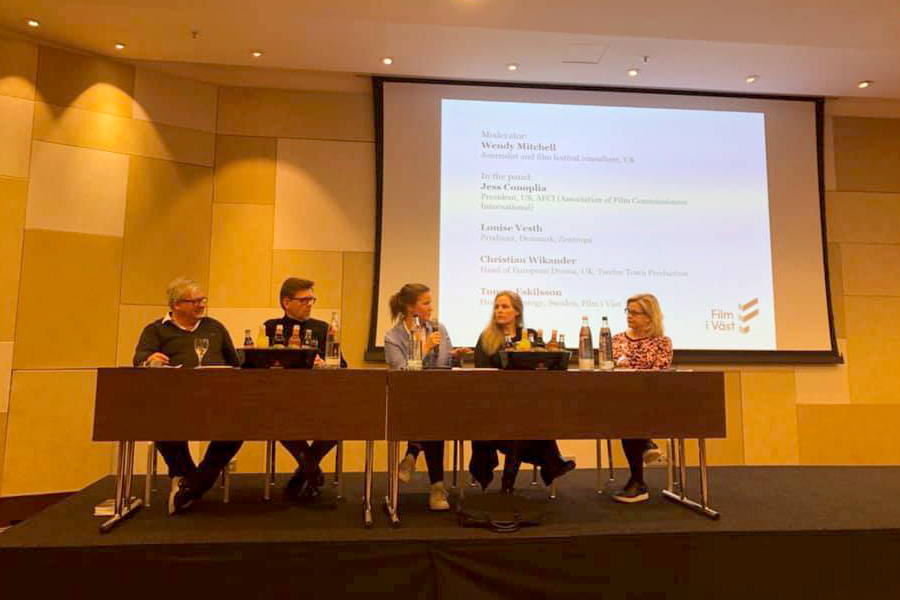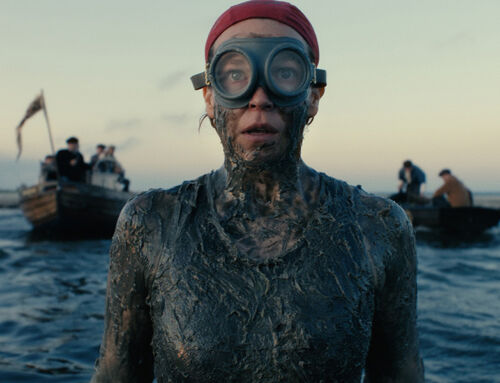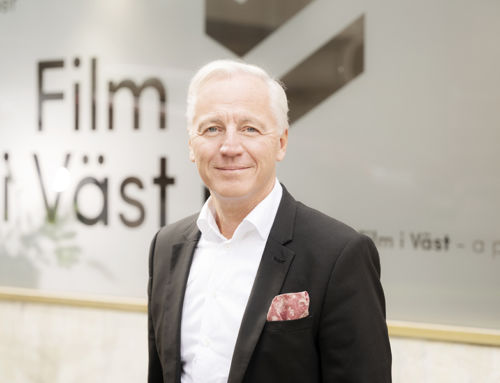Under Berlin Film Festival arrangerade Film i Väst seminariet Drowning in numbers – or how to stay afloat in the current global production deluge, modererat av Wendy Mitchell. I panelen deltog Jess Conoplia, president, AFCI; Louise Vesth, producent på Zentropa; Christian Wikander, Head of European Drama, Twelve Town Production och Tomas Eskilsson, Strategichef på Film i Väst. Leon Forde, Olsberg SPI presenterade en ny rapport som nu finns att ladda ner här. Seminariet arrangeras i samarbete med Göteborg Filmfestivals projekt Nostradamus, Cine-Regio och Olsberg SPI.
Här kan du ladda ner rapporten: Drowning in numbers – or how to stay afloat in the current global production deluge.
Journalisten Wendy Mitchell sammanfattar seminariet så här i en specialskriven text för Film i Väst:
”Film i Väst’s Berlinale seminar asks how industry stays afloat during ‘global production deluge’
Whether you call it a sunny “golden age of content” or a gloomier “global production deluge,” the unprecedented investment in content production and licensing is creating a wealth of new opportunities – and also new challenges – across the value chain of the film and TV industries.
The panel “Drowning In Numbers,” held Feb 23 during the Berlinale, looked more closely at the numbers and the industry changes afoot. The talk was organised by Film i Väst in co-operation with Göteborg Film Festival’s Nostradamus project, and in association with Cine-Regio and Olsberg SPI.
Over $100 billion of investment is flowing into production and licensing of content annually, according to a new report, The Global Production Deluge, previewed at the event by Olsberg SPI managing director Leon Forde. Much of that is being driven by the streamers – not just Netflix (which spent $17bn on content in 2019) but also Amazon, Disney, HBO, Apple, Comcast and others.
Worldwide spending on non-sports content was estimated by Ampere Analysis to be $123 billion in 2018, a 29% increase from $95 billion in 2013. A further rise of 26% over the next five years is forecast.
The content boom has created challenges in many areas of the industry: capacity for workforce and infrastructure (including studio space), questions about who controls the IP rights to all that content, how independent producers and public funders are finding their way in this new world, and if independent features films are being squeezed out by the rise in episodic work.
Forde said in his presentation, “Public funding is a key area of disruption. The impact of the changes that we’re seeing on public funders is profound, and a lot of institutes and support agencies are wrestling with what’s happening in the sector, understanding and communicating value…There are two parts of the coin, which is the inward investment side and the national production side. I think a lot of support bodies are wrestling with this question of how to, how to ensure a successful sector across both of those areas.”
Jess Conoplia, president of the Association of Film Commissioners International (AFCI), said, “One concern that film commissions has is definitely capacity — soundstage space availability is at the top of everyone’s mind. I know multiple commissions are working with the real estate industry, and working with state or national government, to find out what facilities may be available that are disused, which are not purpose-built soundstages, but they can be used [for production].”
She added, “Certainly workforce is another major issue. I think with that challenge though comes a huge amount of opportunity. And we’re working on a project at the moment with Times Up to spotlight the programmes that are in place by commissions around the world to encourage diversity in the sector.” One example is Film London’s Return to Work scheme.
Producers Louise Vesth of Zentropa (Denmark) and Christian Wikander of Twelve Town (UK) both agreed that workforce capacity, and talent availability, are of increasing concern. Vesth, who has produced films including Lars von Trier’s The House That Jack Built and Nikolaj Arcel’s A Royal Affair, said, “I think that the time that I’m able to get with my talents is much less than it has been. And I think that’s a bad thing.”
Christian Wikander, Head of European Drama at Twelve Town (Jordskott II, The Child In Time), agreed that his company “has struggled to find the right talent on several projects, but we also struggle to find the A-crew team behind the camera, so it strikes all over.”
The role of public funders
Vesth thinks the industry can eventually adjust to technical concerns like capacity. But she had a bigger philosophical question. “What consequences does this production boom have to the content? I think a very important question would be, do we need national film institutes in the future? And I don’t know the answer to that. But I really, really hope so.
She continued, “The production boom is maybe created from new money – some of them from regional [funds] and incentives. Working for them means working for another purpose, or brand, than your content.”
She hopes that public funding model continues to exist, because the way she works at Zentropa, “the final cut is concentrated in the inner circle of the DNA, the producer, the director and the screenwriter. And I think that public model supports that.”
Feature films are of course being surpassed by the exponential growth in episodic work. For instance, Netflix alone debuted 371 new original shows and films in 2019 – more than the entire television industry did in 2005.
Tomas Eskilsson, head of strategy at Film i Väst, said, “The volume race will continue in the Nordics, we will do probably five six times more drama than we did just five years ago. But I think the whole industry benefits from a strong feature film industry in our own countries, in our own languages because we probably speak a lot of different languages in different countries. The only way forward for public money is to form stronger alliances with other players to create predictability, for features in production. And that means making decisions extremely much faster than before. Then we can create something that’s interesting for companies and for producers.”
He continued, “It’s a question about what can we support or invest in, can we in something that is 100% owned by a global streamer, or does the production company need to have part of the ownership? Is the reason for public bodies cultural or artistic, or is it industry? I think in Europe, more or less, even if they have economic reasons to exist, there is also a strong backbone that this is a cultural product.”
Eskilsson noted that the number of production companies in Sweden just concentrating on feature films “are slowly melting away, there are fewer and fewer left.” He hopes that Netflix and the over OTT services will evolve to share more rights with independent producers.
Vesth understands why some producers go for the easier, quicker option of getting a greenlight from a major platform, rather than piecing together finance from many sources.
She wants to see the public funders raise their game. “They will have to step up and to join the competition, and not be the garbage can for the leftovers. They have to tell the telling the industry and the world why their way of funding creates better deeper and more important content.”
Wikander said that while Twelve Town has some projects with the global platforms, they also use the more traditional patchwork model when it’s right. “From a business perspective, we still think the co-production model has its upsides,” he said.
Wikander, despite working in episodic drama, says that he respects that some consumers increasingly cherish one-off storytelling, whether 90 minutes or three hours, because they like that “it will actually end” without continuing for countless seasons. He’s also watching the rise of short formats. “The buyers don’t see short format to be a competition for the consumers’ time, you watch it on your way to work or in breaks during work time. You don’t watch [short formats] in the evenings,” he added.
The panel noted that public funders still need to get their heads around how to best support new formats like webseries or Quibi-style shorts; in just one example, The Danish Film Institute, backed the webseries Sex, which premiered at Berlinale Series.
This deluge of content is also flooding cinemas, Eskilsson added. “The competition in the cinema window is actually a lot stronger than before. The chance to perform really well is not as strong as before. Is there really a necessity to to release so many more films in cinemas, when there are alternatives for distribution? I don’t think capacity in cinema will be bigger in the future, in the Western world.”
Vesth said that “consumers are in paradise” with all the content available to them, “but we need to talk about the quality of the minutes that we actually producing. And that again brings us to the concept where we can say that we need to look for the exceptional content. We need an artistic necessity in the work that we’re doing, but that also takes time and that’s my worry is that when we are in this production boom that we don’t have the time that we used to have.”
Short term vs long term
Johanna Koljonen, author of the Nostradamus report, spoke up from the audience to ask, “how do we plan for a boom in the short term, and the contraction in the long term in the at the same time?”
Vesth answered, “For me, it still has to do with the content…We need to stay true to the core of what we’re doing, which is storytelling. And I don’t think that storytelling will ever leave us…We really need to to stay alert to how we are telling stories. We need to be very, very, very good at it.”
Wikander agreed, “Producers working closely with creators need to take control of the stories that we have passion for.”
And Eskilsson is confident that the content boom will eventually halt its rapid growth. “There will be a break in this curve because it cannot go on forever. There will be a point where quality beats quantity.”






